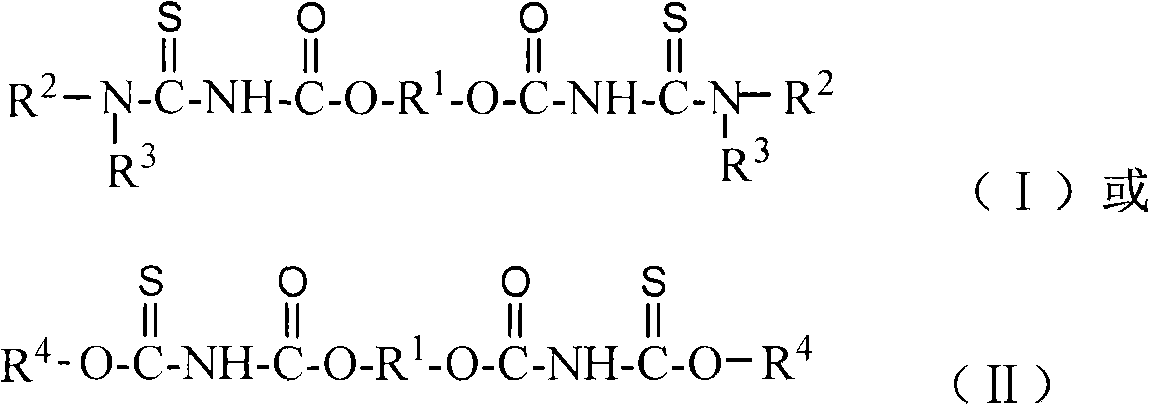Use of diester isosulfocyanate in sulphide ore floation and preparation method thereof
A technology of diester group diisothiocyanate and diester group dithiocarbamate, which is applied in the field of preparation of such compounds, can solve the problems of poor selectivity and low level of comprehensive utilization of sulfide ores, and achieve simple preparation process, The effect of good selectivity and strong collection ability
- Summary
- Abstract
- Description
- Claims
- Application Information
AI Technical Summary
Problems solved by technology
Method used
Image
Examples
Embodiment 1
[0038] Example 1 Preparation of 1,4-butylene bis(oxycarbonyl isothiocyanate)
[0039] 38.0 servings of NH 4 SCN was dissolved in 70 parts of water, the mixture was added dropwise to 43.2 parts of bis-chloroformate under stirring, and 0.24 parts of bis(4-N,N-dimethylaminophenyl)methane was added to control the reaction temperature. The temperature is about 0℃~6℃, and the reaction is carried out under stirring for 3h. After stopping stirring, the mixture was allowed to stand at a temperature of about 2°C for about 30 minutes, and the mixture was separated into an aqueous phase and an organic phase. After separating and removing the water phase, the obtained orange-red organic phase is the desired 1,4-butylene bis(oxycarbonyl isothiocyanate). The product yield based on ethylene bischloroformate was 93.6%.
Embodiment 2
[0040] Example 2 Preparation of 2,2'-ethylidene bis(oxycarbonyl isothiocyanate)
[0041] 24.3 parts of NaSCN were added to 50 parts of dichloromethane, and 2.0 parts of PEG-400 were added simultaneously, and a solution consisting of 23.1 parts of diethylene dichloroformate and 30 parts of dichloromethane was added dropwise to the above reaction solution under stirring. In the process, the reaction temperature was controlled to be about 5°C to 15°C, and the reaction was carried out under stirring for 4 hours. The obtained orange-red dichloromethane solution contained the target product 2,2'-ethylene ether bis(oxycarbonyl isothiocyanate). The yield based on diethylene bischloroformate was 95.2%.
Embodiment 3
[0042] Example 3: Synthesis of O,O'-dibutyl-N,N'-butylene dithiocarbamate
[0043] Take 0.1 mol of 1,4-butylene bis(oxycarbonyl isothiocyanate) synthesized according to Example 1, add 0.3 mol n-butanol to it under stirring, and stir and react at 40 ° C for 2 hours after adding, During the reaction, the color of the reaction solution gradually changed from orange-red to bright yellow to obtain a reaction solution containing O,O'-dibutyl-N,N'-butylene dithiocarbamate, which can be used as sulfide ore without purification Flotation collectors. The yield of O,O'-dibutyl-N,N'-butanediesteryl dithiocarbamate was 97.5% based on 1,4-butylene bis(oxycarbonyl isothiocyanate).
PUM
 Login to View More
Login to View More Abstract
Description
Claims
Application Information
 Login to View More
Login to View More - R&D
- Intellectual Property
- Life Sciences
- Materials
- Tech Scout
- Unparalleled Data Quality
- Higher Quality Content
- 60% Fewer Hallucinations
Browse by: Latest US Patents, China's latest patents, Technical Efficacy Thesaurus, Application Domain, Technology Topic, Popular Technical Reports.
© 2025 PatSnap. All rights reserved.Legal|Privacy policy|Modern Slavery Act Transparency Statement|Sitemap|About US| Contact US: help@patsnap.com



